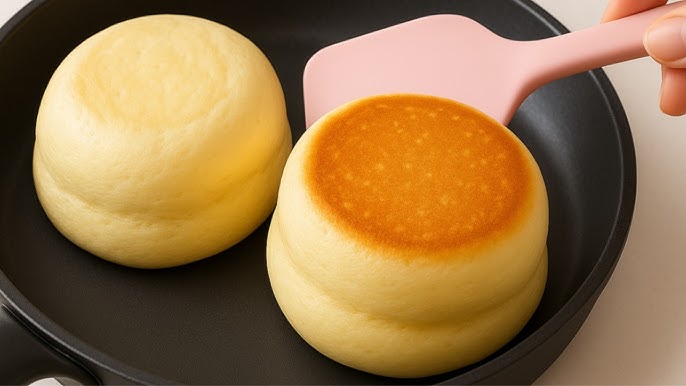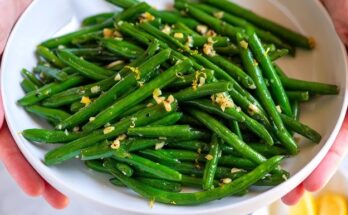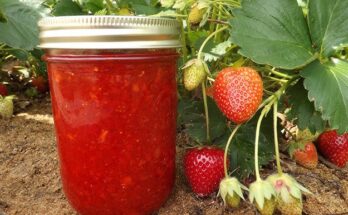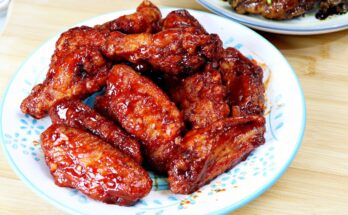Fluffy Japanese Pancakes Recipe: Ever seen those ultra-thick, bouncy pancakes on Instagram or TikTok and thought, “How do they make them so fluffy?” Welcome to the world of Japanese soufflé pancakes – soft, airy, and practically melt in your mouth. Unlike the traditional American flapjacks, these heavenly stacks are a cloud-like treat that turn breakfast into a dessert-worthy occasion. They may look tricky, but with the right tips and patience, you can absolutely master them at home.
Fluffy Japanese pancakes are made using meringue (whipped egg whites), which gives them their signature rise and texture. Think of them as a cross between a pancake and a soufflé – hence the name “soufflé pancakes.” This guide breaks down every step, every ingredient, and every trick in the book to ensure your pancakes puff up perfectly and taste incredible.
Whether you’re making these for brunch, dessert, or a special breakfast-in-bed moment, this recipe will wow your taste buds and your Instagram feed.
Why Are Japanese Pancakes So Unique?
What sets Japanese pancakes apart isn’t just their appearance – though their sky-high fluffiness definitely steals the show – it’s their texture and technique. These pancakes are:
- Thicker and taller than regular pancakes.
- Lighter and airier because of the meringue.
- Cooked low and slow to maintain height and avoid burning.
- Made with simple ingredients but require precise technique.
The fluffy texture comes from carefully folding stiff egg whites into a smooth batter. This incorporates air, almost like making a sponge cake. Then, by cooking them slowly on low heat, the pancakes set without collapsing. You don’t flip these pancakes like your everyday ones – instead, you lift and support them gently, like handling a souffle.
This isn’t just a breakfast—it’s a showstopper. Whether you’re aiming to impress or indulge, these pancakes deliver something magical every time.
Essential Tools You’ll Need
Before diving into the recipe, let’s get your kitchen armed and ready. These tools are non-negotiable if you want to achieve that perfect soufflé-like height and bounce.
Mixing Bowls
You’ll need at least two medium-to-large mixing bowls – one for the yolk batter and one for whipping the egg whites. Glass or stainless steel bowls work best for whipping meringue.
Hand Mixer or Stand Mixer
Unless you’re planning an arm workout, a hand mixer (or better, a stand mixer) is essential for beating the egg whites to stiff peaks. Whipping by hand is possible, but be prepared for some serious whisking.
Non-Stick Skillet or Griddle
A heavy-bottomed non-stick skillet or griddle ensures even heat and prevents your pancakes from sticking. A lid is also crucial to trap steam and help cook the pancakes through.
Pancake Molds (Optional but Recommended)
Ring molds help control the shape and height of your pancakes, giving that signature round, towering look. However, with careful shaping and patience, you can make them free-form as well.
Ingredients You’ll Need
Let’s talk ingredients. You don’t need anything too fancy – the beauty of this recipe is its simplicity. But precision matters. Get everything measured and ready before you start.
Core Ingredients List
Here’s what you’ll need for about 3-4 pancakes (serves 2 people):
- 2 large eggs, separated
- 2 tablespoons milk
- ½ teaspoon vanilla extract
- ¼ cup all-purpose flour
- ½ teaspoon baking powder
- 2 tablespoons granulated sugar
- Butter or neutral oil, for greasing the pan
Optional Add-ins and Toppings
Want to take things to the next level? Try adding or topping with:
- Fresh fruits – strawberries, blueberries, or bananas
- Whipped cream
- Powdered sugar
- Maple syrup or honey
- Chocolate sauce or Nutella
- Matcha powder or cocoa for flavor twist
Tips Before You Start Cooking
Success with Japanese pancakes lies in the prep work. Here are a few important pre-cooking tips:
- Use room temperature eggs: They whip better and give more volume.
- Preheat your skillet on low heat: Don’t rush it; gentle heat is key.
- Avoid overmixing: Fold your meringue into the batter gently to avoid deflating it.
- Work quickly: Once the meringue is folded in, cook immediately.
- Keep a lid handy: You’ll need to steam the pancakes slightly to cook them through.
A little planning goes a long way. Have everything in place before you whip the egg whites — once that meringue is ready, it’s game time.
Step-by-Step Guide to Making Fluffy Japanese Pancakes
Now for the fun part. Let’s walk through the whole process, one step at a time. Don’t rush it, and enjoy the journey – your fluffy masterpieces await.
Step 1: Preparing the Batter
Start by whisking together egg yolks, milk, vanilla, and a bit of sugar. Add sifted flour and baking powder, mixing just until smooth. This forms the base of your light, airy pancakes.
Step 2: Whipping the Egg Whites
In a separate bowl, beat the egg whites with sugar until stiff peaks form. The meringue is what gives Japanese pancakes their signature height and cloud-like texture.
Step 3: Folding the Meringue Gently
Fold the meringue into the batter in three portions, using a gentle scooping motion. Avoid overmixing—keeping the air in the batter is crucial for fluffiness.
Step 4: Heating the Pan Just Right
Preheat a lightly greased nonstick pan over low heat. Slow, gentle heat prevents burning and allows the pancakes to rise properly.
Step 5: Cooking the Pancakes Slowly
Scoop tall mounds of batter into the pan. Cover and cook slowly, adding a spoonful of water to create steam. Flip carefully and cook until both sides are golden and jiggly. Enjoy immediately!
How to Flip Japanese Pancakes Without Deflating Them
Flipping these cloud-like beauties is where the magic can fall apart—literally. One wrong move, and your lofty pancake can collapse like a house of cards. But don’t worry—here’s how to flip them without turning them into flat pancakes.
- Use a wide spatula or two: The more surface area you support, the less chance of the pancake breaking or deflating.
- Tilt the pan gently to help you slide the spatula underneath the pancake without squashing it.
- If you’re using a ring mold, remove it gently with tongs or a knife run along the inside edge, then flip with care.
- Flip quickly but gently: Don’t overthink it. One confident movement does the trick.
- If you’re using a second spatula or spoon, use it to stabilize the top while flipping.
- Cover the pan again and let the second side steam cook low and slow.
Pro tip: Add another teaspoon of water to the pan before covering it again—this helps keep the cooking environment humid and perfect for fluffy pancakes.
Serving Suggestions
So, your pancakes are cooked to perfection—tall, bouncy, and golden. Now comes the best part: plating and devouring. Japanese pancakes are best eaten warm, fresh out of the pan, while they’re still jiggly and cloud-like.
Here’s how to serve them like a true café pro:
- Stack them high (usually 2–3 pancakes).
- Dust with powdered sugar for that classic look.
- Top with a scoop of whipped cream or ice cream for a luxurious finish.
- Drizzle with maple syrup, honey, or condensed milk.
- Add a handful of fresh fruits—berries, banana slices, or mango work beautifully.
- Want a café-style plate? Add a sprig of mint and a dusting of cocoa or matcha.
Insider tip: Serve quickly—Japanese pancakes tend to shrink slightly as they cool. They’re meant to be jiggled, sliced, and savored right away!
Delicious Topping Ideas
Want to get creative? Here are some topping combinations that’ll turn your already-amazing pancakes into gourmet masterpieces:
Classic Sweet Toppings
- Maple syrup + whipped cream
- Honey + crushed pistachios
- Butter + powdered sugar
Fruity Favorites
- Strawberries + whipped cream
- Blueberries + lemon zest
- Bananas + Nutella
Decadent Dessert Style
- Chocolate ganache + Oreo crumbs
- Matcha cream + red bean paste (for a Japanese twist)
- Caramel sauce + roasted pecans
Savory Alternatives
Yes, they’re traditionally sweet—but these can also go savory:
- Smoked salmon + cream cheese
- Fried egg + avocado + microgreens
- Ham + cheese sauce
No matter how you top them, these pancakes are incredibly versatile and can suit any craving.
Common Mistakes to Avoid
If you’ve tried making these pancakes before and ended up with a sad, flat pile—don’t worry. Here’s what might’ve gone wrong and how to fix it next time:
- Overmixing the batter: This deflates the meringue. Gently fold to keep the air.
- Undermixing: You need to fully incorporate the meringue without streaks. Find that balance.
- Cooking over high heat: These pancakes need low and slow heat to rise and cook through without burning.
- Opening the lid too soon: Traps steam is key—lifting the lid prematurely stops that.
- Egg whites not whipped enough: Stiff peaks are essential. If they flop over, your pancakes will, too.
- Not using a timer: Eyeballing can lead to overcooked outsides and undercooked centers.
Success lies in gentle mixing, patient cooking, and attention to detail. Stick to the process and you’ll be amazed!
How to Store and Reheat Japanese Pancakes
Let’s say you made a batch but couldn’t finish it all (we doubt it, but hey, it happens!). Here’s how to store and bring them back to life:
To Store:
- Allow pancakes to cool completely.
- Wrap each pancake individually in plastic wrap or store in an airtight container.
- Refrigerate for up to 2 days.
To Reheat:
- Microwave: 20–30 seconds per pancake. Place a damp paper towel over it to retain moisture.
- Steaming: Use a steamer basket or colander over boiling water for about 2–3 minutes. This is the best method for reviving the original texture.
- Pan Reheat: Use low heat and cover the pan to gently warm them back up.
Avoid reheating in a toaster or oven—they’ll dry out and lose that pillowy texture.
Nutritional Information (Per Serving)
Here’s a rough breakdown based on 2 pancakes (without toppings):
| Nutrient | Amount |
|---|---|
| Calories | ~180-220 kcal |
| Protein | ~6g |
| Carbs | ~25g |
| Sugars | ~10g |
| Fat | ~8g |
| Fiber | ~1g |
Add toppings like whipped cream or syrup, and the calorie count will increase—but hey, life’s about balance, right?
Vegan and Gluten-Free Variations
Trying to eat plant-based or gluten-free? You can still enjoy these delightful pancakes!
Vegan Version:
- Replace eggs with aquafaba (chickpea water) for the meringue.
- Use plant-based milk (like oat or soy).
- Add apple cider vinegar to help create volume and stability in your aquafaba meringue.
Gluten-Free Version:
- Substitute all-purpose flour with a 1:1 gluten-free baking flour blend.
- Ensure your baking powder is gluten-free.
Note: Vegan versions won’t be quite as jiggly, but they’ll still be soft and delicious!
Japanese Pancakes vs. American Pancakes
Let’s settle this delicious debate. How do these two flapjack styles really compare?
| Feature | Japanese Pancakes | American Pancakes |
|---|---|---|
| Texture | Light, airy, soufflé-like | Dense, fluffy |
| Thickness | Very tall | Medium |
| Cooking Style | Steamed in pan with lid | Fried or grilled |
| Sweetness | Mild | Varies |
| Technique | Whipped meringue | Straightforward mixing |
| Best Served | Fresh, warm, plated | Stack with syrup |
They’re both amazing—but if you’re looking for something that feels like eating a vanilla cloud, the Japanese version wins hands down.
Final Tips for Perfect Results Every Time
Let’s recap a few golden rules for pancake perfection:
- Use fresh eggs and separate them carefully.
- Whip egg whites to firm stiff peaks.
- Fold slowly and lovingly – no rough mixing allowed.
- Cook low and slow. Seriously.
- Use molds for shape, but don’t stress if you don’t have them.
- Keep your lid on while cooking to create steam.
Practice makes perfect. Even if your first attempt isn’t café-quality, keep at it. The reward is absolutely worth it.
FAQs about Fluffy Japanese Pancakes Recipe
1. Can I make Japanese pancakes without a mold?
Yes! Just scoop the batter into tall piles on the pan. They may spread slightly but will still puff up beautifully if the batter is well-whipped and the pan is covered.
2. Why do my pancakes collapse after cooking?
Usually because the meringue was either under-whipped or over-mixed into the batter. Also, sudden temperature changes or flipping too roughly can cause them to deflate.
3. Can I freeze Japanese pancakes?
Yes, wrap them tightly and freeze for up to 1 month. Reheat by steaming or microwaving with a damp towel to restore fluffiness.
4. What flour works best for this recipe?
All-purpose flour works just fine. For a finer texture, you can try cake flour, but it’s not required.
5. How do I know when they’re cooked through?
Use a toothpick—insert it into the center of the pancake. If it comes out clean, you’re good to go. Also, gently press the top—it should spring back without leaving a dent.
Conclusion
Japanese fluffy pancakes aren’t just a meal—they’re an experience. Soft, pillowy, and oh-so-jiggly, they elevate breakfast (or brunch or dessert) into something almost magical. With simple ingredients, a little patience, and the tips in this guide, you can recreate that signature café-style pancake tower right in your own kitchen.
It might take a few tries to nail the technique, but once you do, you’ll be flipping and fluffing like a pro. So go on, give it a shot—your breakfast game will never be the same again.



